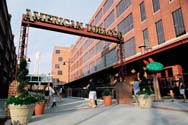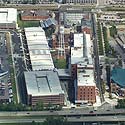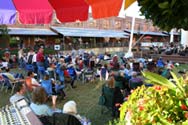American Tobacco has been in the news lately, featured in two different publications for the changes the renewal of the campus have wrought on downtown Durham.

CBC’s renovation & rejuvenation of the American Tobacco Campus in downtown Durham has received multiple awards & accolades over the years since the project began. |
From the National Historic Trust Preservation Blog
The National Trust Historic Preservation published an article about American Tobacco on the non-profit’s blog. Erica Stewart penned the article entitled “Durham’s Historic Tobacco Buildings Ignite Bull City’s Growth for the Second Time.”
Stewart’s article focuses on the investment the National Trust Community Investment Corporation (NTCIC) made in American Tobacco, to help make Capitol Broadcasting Company’s renovation of the property a possibility.
She writes, “The 13-acre complex, totaling approximately one million square feet, was abandoned at the south end of downtown in 1987. As the former center of Durham’s identity and its primary employer, the fate of the American Tobacco district and the health of downtown Durham were inextricably linked. Today those thick brick walls are humming again, recast as the home to top-notch office space (among them Duke University’s corporate education school, a North Carolina NPR affiliate, advertising firms, software companies and smaller businesses and nonprofits), five restaurants, a YMCA and a 2,800-seat new performing arts center.”
Stewart credits the rejuvenation of the section of downtown Durham to American Tobacco.

Once an empty, abandoned shell, American Tobacco is now a thriving hub in downtown Durham. |
“This transformation is the largely thanks to the vision and dogged determination of the Capital Broadcasting Corporation (CBC), the owner of the Durham Bulls minor-league franchise which occupies a ballpark immediately adjacent to the complex. CBC acquired the campus in 2002 and, after failing to convince conventional bankers, secured $13 million in equity from NTCIC and $40 million from a community-based lending institution located across the train tracks from the project site. CBC launched the first phase of the project in 2004.”
Stewart commented on the jobs the renovated campus brought to downtown Durham, as well as the improved property values to the area.
“Equally impressive is the economic impact of the American Tobacco project,” she writes.
She concluded: “The real bottom line, which shouldn’t be lost in the tally of impressive figures and square footage, is that now downtown Durham is a lively, vibrant, interesting place to be, at all times of day or night. And best of all, the American Tobacco project was able to change people’s assumptions about what they thought downtown to be, what it could be, without allowing its rich architectural heritage and history to go up in smoke.”
From “Our State” Magazine
American Tobacco also got press in North Carolina’s “Our State” magazine this month. In the October 2010, edition, downtown Durham was one of five regions featured in “Places with a Past.”

The central lawn at American Tobacco is now a hot spot for free concerts and other family-friendly events. |
News & Observer writer Josh Shaffer penned the article about Durham & American Tobacco.
He begins, “When the tobacco industry left town, so did a piece of Durham’s spirit. But two decades after American Tobacco produced its last cigarette here, a reinvented campus on the same site thrives with businesses built for the future, giving the city a new soul, rising from the ashes.”
Shaffer focuses on how The American Tobacco Company took much of the life of downtown with it when the cigarette company closed its doors for good in 1987. He tells stories of those working in the factory and the devastation that rained down when it folded.
“But perhaps the most fascinating chapter in Durham’s history is unfolding now inside those same buildings, which sat empty for more than a decade” writes Shaffer. “The irony isn’t lost on anyone that tobacco, which for so long helped fuel the Bull City’s image as a haven for sin, is providing a new wave of lifeblood.”
Shaffer quotes American Tobacco Vice President Michael Goodmon as saying the reason CBC’s venture with the hollowed-out buildings is “that nobody involved had much of an idea what they were getting into.”
 |
 |
| The Lucky Strike tower is a central focus of the campus, the roof for the stage & becomes a beacon during the holidays with thousands of Christmas lights. |
Shaffer writes, “Had they been real estate developers, instead of the folks who put the nightly news on WRAL, they would have balked at spending more than six years rebuilding a century-old industrial wasteland based around a product so prohibited you could hardly smoke it on the property.
“A normal developer wouldn’t have built a quarter-mile artificial river through the middle of an office complex, or completed that river with jagged concrete chunks that act as stepping stones, just to enhance the theme.
“They wouldn’t have taken such care to preserve the nuts-and-bolts factory look of the place, which earned them both tax credits and admiration and helped lure some of the old life back to downtown.”
Shaffer weaves the past with the present in the article, and ends by saying, “In this way, American Tobacco has again become Durham’s beating heart. The characters who inhabit the campus now may dress a little differently, and speak in different accents, but there’s no doubt they’re at the center of Durham, where history keeps happening.”
Thanks to American Tobacco for these capcom photos.